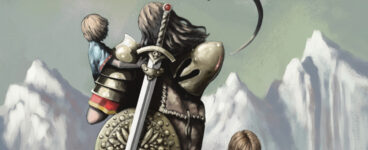‘The bonds of our girlhoods, I believe, can be romantic but they are not romantic. Rather, there is something discomforting about their fierceness, their hypersensitivity, their lack of abandon.’
Friendships can be the foundation of our earliest memories and most formative moments, so why are they often seen as secondary to romantic, or familial connection, something to age out of and take a back seat to other relationships? In BFFs, Anahit Behrooz examines of the power of female friendship, not as something lesser, but as a site of radical intimacy, with reference to the work of Toni Morrison and Elena Ferrante, Booksmart and Grey’s Anatomy, Insecure, The Virgin Suicides and beyond. In this extract, Behrooz looks at the work of filmmaker Céline Sciamma and author Toni Morrison.
BFFS: The Radical Potential of Female Friendship
By Anahit Behrooz
Published by 404 Ink
There is a wayward delight in watching a genre burst at its seams, become expansive and disorderly and all-encompassing. The increasingly gendered and intersectional concerns of the coming-of-age story allow us to see not only the emotional and psychological maturation of previously ignored protagonists, but the social and political conditions which inform their lives. And the social and political is always, always collective. As in Sciamma’s Girlhood, the rich archive of this kind of tale is dense not only with individual identity formation, but with the interdependence of the group, with the ways in which we come of age together. Childhood, these stories understand, is a wonderfully and frighteningly porous thing. We are raised as much by our friends – the small, equally unformed beings scattered around us – as we are by our parents and guardians: taught at their bloody, gingham-ed knees not just who we want to be, but how we want to be loved.
Miles away from the strict education novels of the late-eighteenth century, the long history of the female coming-of-age story pulls at the tension between the individual and the communal, navigating the strange chaos of growing selfhood alongside our capacity for headlong, pluralising intimacy. Contained within these friendships is something intense and precarious that subverts the supposed idyll of childhood: all the untapped desires of our inchoate selves meeting the demands of increasingly rigid assemblies of femininity. The bonds of our girlhoods, I believe, can be romantic but they are not romantic. Rather, there is something discomforting about their fierceness, their hypersensitivity, their lack of abandon. Liquid bright and malleable, we form ourselves within our cohorts, both alone and together. As we come of age, so do our friendships, their intimacies pulled in the bruised wake of adolescent anguish. There is so much potential for loveliness here. There is so much potential for shatter.
Toni Morrison’s Sula is a book about such friendship, its knitted beauty and unnerving brutality. The events of the novel are set in a small Black neighbourhood in the uplands of Ohio in the 1920s and ’30s, and the narrative takes its time to get to the eponymous Sula and her strange, feverish sisterhood with Nel, the quiet, obedient girl she befriends in their youth. Rather, the first third tells the history of their community: the Bottom, a wooded, hilled area ‘gifted’ by a slave owner to a previously enslaved man whom he tricks into accepting the agriculturally inferior land. This exercise of malicious white power lays the groundwork for everything: the poverty that dogs Sula and Nel’s childhoods, the violence that scaffolds their intrepid attachment. Tender and impetuous though it may be, their friendship is never quite allowed innocence, not really, too embroiled as it is in the hostility of its surroundings. Early on, when four white boys torment Nel on her way home from school, Sula wordlessly pulls out a paring knife and slices off the tip of her finger. ‘If I can do that to myself,’ she asks them, ‘what you suppose I’ll do to you?’ Blood may be thicker than water, but Sula and Nel’s friendship becomes evidence of the long-forgotten fullness of this axiom: the blood of the covenant is thicker than the water of the womb, the ties that we choose stronger than the ones we are born into.
In the slow drip-drip of her blood, in the tiny scrap of flesh left on the road, Sula renders her very self open and permeable to the muddle of her and Nel’s girlish connection. Images of such porosity wind throughout: Sula and Nel silently lying against each other in the grass, each unconsciously copying the other in gestures and play; Sula and Nel walking in tandem past a crowd of men in the multiplied burgeoning of their sexuality; Sula recalling in adulthood ‘the days when we were two throats and one eye and we had no price.’ On the cover of my copy – a 1980 edition bound in plastic from the public library – two little girls appear silhouetted, surrounded by a ghostly, or perhaps an angelic, glow. They look practically the same, although not much can be made out except four large eyes and two smock dresses covering gangly limbs. But towards the bottom the dresses begin to merge, blurred into a single garment that holds the girls attached at the waist, the hips, their covered knees; a gradual and willing immersion.
In her reading of Sula in The Paris Review, Namwali Serpell writes about Morrison’s insistence on such instability, about her investigation of the sly potential of girlhood friendship to reconstitute the self. ‘I’m feeling this trembling time,’ Serpell writes, ‘its desire and ache… this girlish queerness – neither straight nor lesbian exactly, but feverish with slant possibility – this dewy conspiracy of selves.’ In literature, the theme of the double – materialising as twins and echoes and unlikely sympathies – has long typically signalled a Gothic uncanniness, a signifier of psychological fracture, but here in Sula its presence is perversely restorative. Friendship as dewy conspiracy, underground collusion. The strange twinning of Nel and Sula’s relationship is eerie not in its fragmentation of the self but in its disobedience of individual selfhood, refusing the placid singularity that these narratives ought to entail. The transgression of their bond disturbs the normativity of their surroundings: together, the girls watch in horror as a child they play with drowns, they feel the undisguised lust of male gazes on their bodies, they replace the lost love of their parents with their own. ‘You. Sula. What’s the difference?’ Nel is asked in adulthood, as they – long past the days of childhood osmosis – collapse together again, and again.
BFFs: The Radical Potential of Female Friendship by Anahit Behrooz is published by 404 Ink, priced £7.50.
ALSO IN THIS ISSUE

 The Space Between Us
The Space Between Us
‘She saw clear skies, stars bulleting the blackness, the full moon. She thought about the distance t …

 A Woman of the Sword
A Woman of the Sword
‘Dead cold blank eyes, the cold set of his teeth. The sword in his hand trembled. It knew, the bronz …













